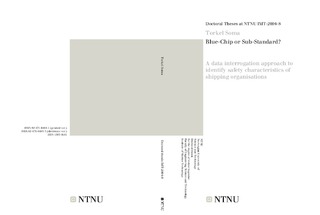| dc.contributor.author | Soma, Torkel | nb_NO |
| dc.date.accessioned | 2014-12-19T12:05:22Z | |
| dc.date.available | 2014-12-19T12:05:22Z | |
| dc.date.created | 2009-02-16 | nb_NO |
| dc.date.issued | 2004 | nb_NO |
| dc.identifier | 220030 | nb_NO |
| dc.identifier.isbn | 82-471-6484-1 (printed ver.) | nb_NO |
| dc.identifier.isbn | 82-471-6483-3 (electronic ver.) | nb_NO |
| dc.identifier.uri | http://hdl.handle.net/11250/237673 | |
| dc.description.abstract | The objective of this thesis describes the characteristics that distinguish shipping companies that have a superior safety standard, called blue-chip, from those being substandard. The different characteristics of the companies having different safety standard are important to be aware of, as they indicate how safety may be improved in ship transportation. The scope of the study is limited to focus on recurrent high-risk accident scenarios arising in ship organisations and systems that are assumed to be of a complex nature. In order to establish this insight safety is considered in a broad context, ranging from what happens at the operational scene, back to the strategies and tactics adopted by the shipping companies. The analytical approach emphasise on data interrogation. According to Fragola (2003) “Data “interrogation” is the process of data collection and investigation from a variety of perspectives, alternatively dissecting it into its underlying (yet often unknown) patterns”.
This approach has made it possible to consider the safety level, and the safety culture of organisations, in relation to the economical conjectures of the business. It was found that the safest companies had a more mature safety culture. This maturity measurement focused on the organisations underlying pattern of safety attitudes, beliefs and values. Another section of the thesis found that the accident risk of shipping companies follows an inverse relationship to the economical performance of the company. When the economical performance in shipping decline, the accident risk increase and vice versa. Both the strength of the relationship and its instant effect are important to be aware of. While changes in safety culture are assumed to take years, the relationship to economical performance is instant and also seems to occur within mature safety cultures. It seems as if the organisations switch between different modes of interest, while the underlying pattern of values, beliefs and attitudes may remain unchanged. Because this relationship can be supported with quantitative evidence, this study has contributed to the causal understanding of ship accidents and safety in general. A question is raised whether it is correct to use terms like organisational accidents or system accidents, as these seem to be rooted in economical parameters. Therefore the term Commercial Accidents is proposed. The thesis is structured in a series of ten papers. | nb_NO |
| dc.language | eng | nb_NO |
| dc.publisher | Norges teknisk-naturvitenskapelige universitet, Fakultet for ingeniørvitenskap og teknologi, Institutt for marin teknikk | nb_NO |
| dc.relation.ispartofseries | Doktoravhandlinger ved NTNU, 1503-8181; 2004:8 | nb_NO |
| dc.title | Blue-Chip or Sub-Standard?: A data interrogation approach to identify safety characteristics of shipping organisations | nb_NO |
| dc.type | Doctoral thesis | nb_NO |
| dc.contributor.department | Norges teknisk-naturvitenskapelige universitet, Fakultet for ingeniørvitenskap og teknologi, Institutt for marin teknikk | nb_NO |
| dc.description.degree | dr.ing. | nb_NO |
| dc.description.degree | dr.ing. | en_GB |
